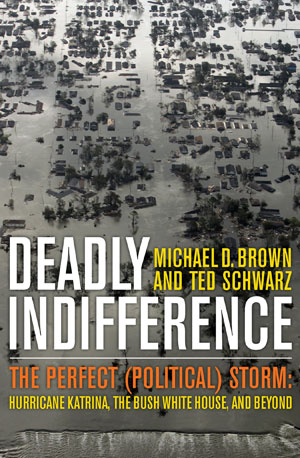 In detailing his side of the Hurricane Katrina debacle nearly six years after the fact, former FEMA head Michael Brown seemingly just wants to clear his name. He feels he was made the scapegoat and believes, rightfully so, that there was much more behind the worst major disaster response in U.S. history than his agency's failings.
In detailing his side of the Hurricane Katrina debacle nearly six years after the fact, former FEMA head Michael Brown seemingly just wants to clear his name. He feels he was made the scapegoat and believes, rightfully so, that there was much more behind the worst major disaster response in U.S. history than his agency's failings.He highlights the political and personal rift between then-New Orleans Mayor Ray Nagin and then-Louisiana Governor Kathleen Blanco. He explains the true role of FEMA, which, by law, is a coordinator, not provider, of resources. He recounts how the executive branch lost sight of the agency's all-hazards responsibility following 9/11 when it was lumped into the Department of Homeland Security, which at the time had an all-terrorism-all-the-time concentration. And he wastes no opportunity to disparage his colleague and then-chief of Homeland Security, Tom Ridge.
In fairness, Brown does recognize his own role in all of this. He began as the agency's general counsel prior to September 11 and rose in prominence within FEMA in the ensuing years. This, by his own admission, coincided with the agency increasingly losing its focus on natural disasters. Not even the brutal 2004 hurricane season, in which five named storms made landfall in Florida, was enough to re-emphasize the fact that Mother Nature strikes much more frequently than any terrorist group.
Brown blames himself for not being able to convince President George W. Bush of this fact. "That's where I failed," wrote Brown.
He continues, recounting one day in particular in which he was riding alongside the commander in chief in the presidential limo, better known as "The Beast," but was too intimidated by the man (and the car, he notes) to speak his mind. "I did not have the courage to say 'I don't think you understand how the agency is falling apart, sir. I don't think you understand what we are facing far beyond external attack and regional disasters.' ... I didn't have the courage to speak up and say that a critical department was being limited in what it could do solely through mismanagement."
This admission comes almost exactly half-way through the book. And after reading the first 100 pages, it was more self-blame than I expected to encounter. Of course, even in admitting this failure, he is placing the bulk of the fault on the system -- one whose structure he watched unravel but could do nothing to repair.
There is, however, little he finds wrong with FEMA's response after the hurricane hit. He recognizes that there were challenges, but as he reminds us continually, the failure of Nagin and Blanco to call for evacuations (due to their political calculations) and the failure of the Army Corps of Engineers to maintain the levees were greater than any logistical problems his agency created -- or at least failed to solve.
In this, he is correct. The picture he paints is one that highlights the limited power FEMA can legally wield. What he has written is, to my knowledge, all factually accurate. But readers who watched New Orleans drown will have trouble with the author's tone and lack of remorse. It isn't so much the arguments he makes but the way he makes them.
At worst, the book can be summed up as a man telling the world that this wasn't his fault. At best, it is a man saying he was powerless to fail any less spectacularly.
This isn't what people will want to hear. Especially for those directly affected by the worst disaster to ever hit the nation, a more apologetic stance would be expected. You didn't do "a heckuva job, Brownie." It would just be nice to read an admission from him that doesn't skirt so much responsibility.
